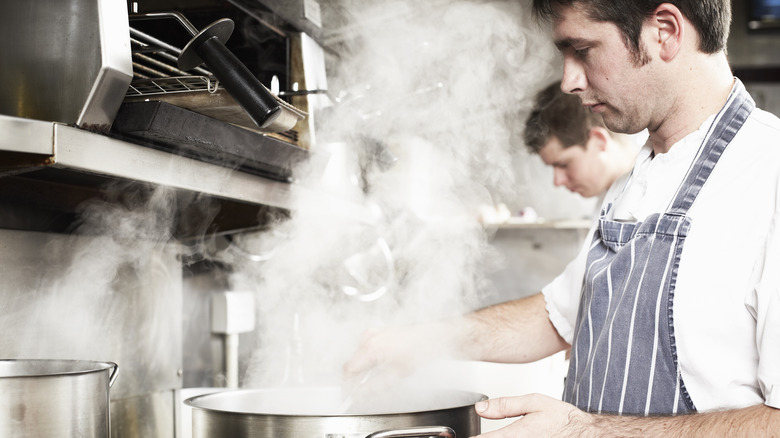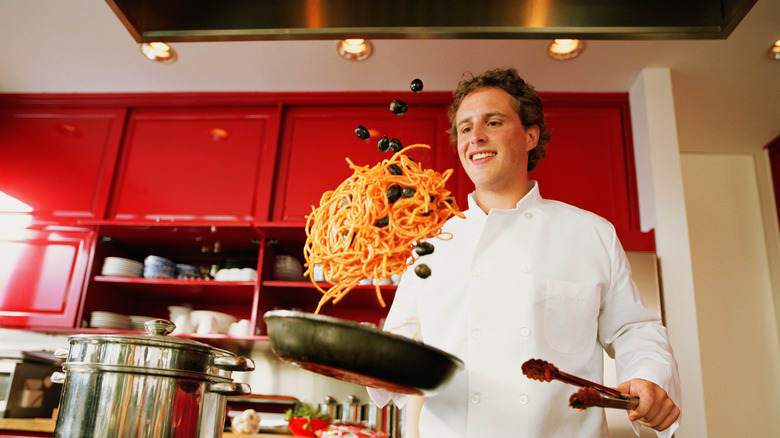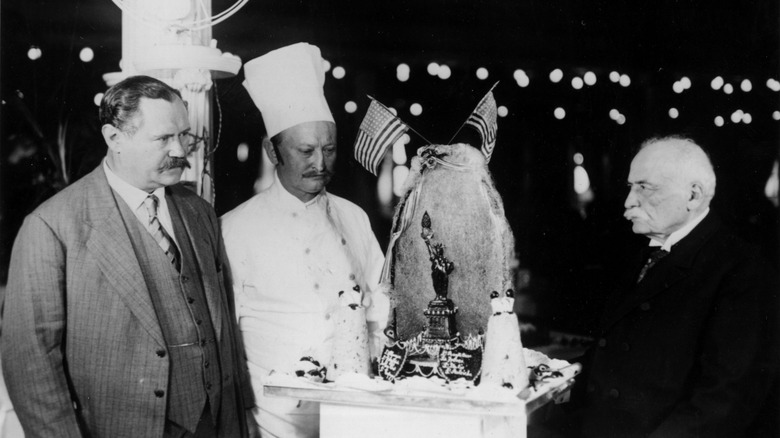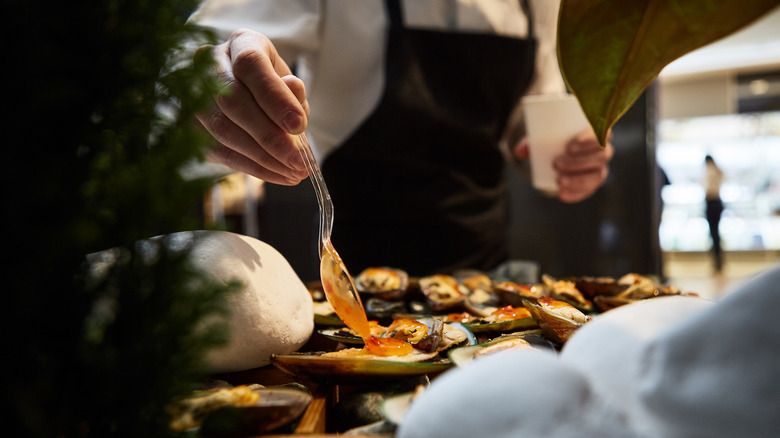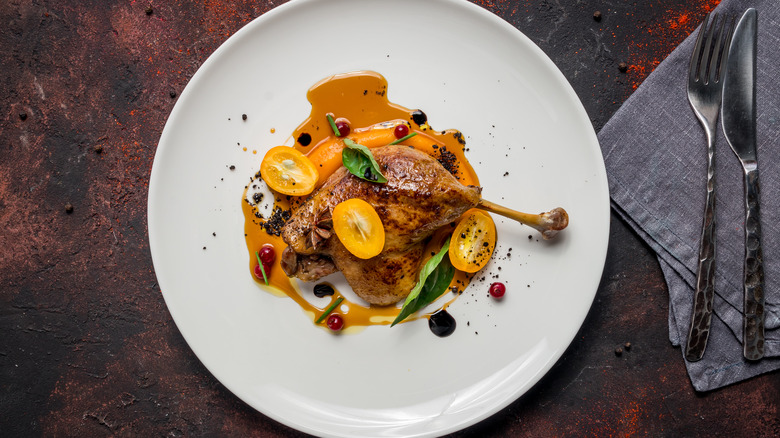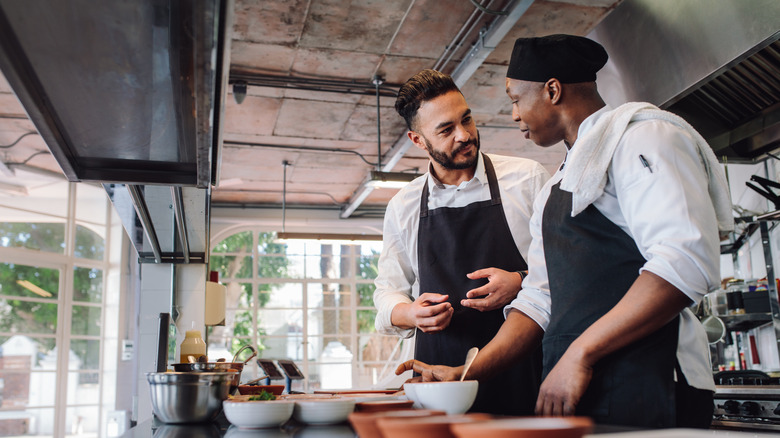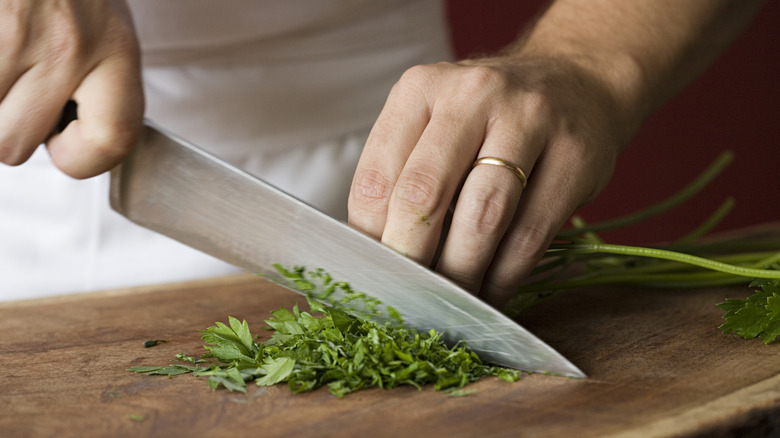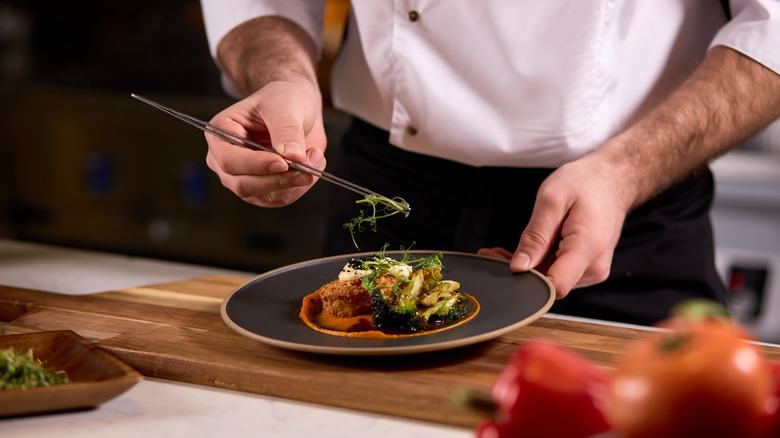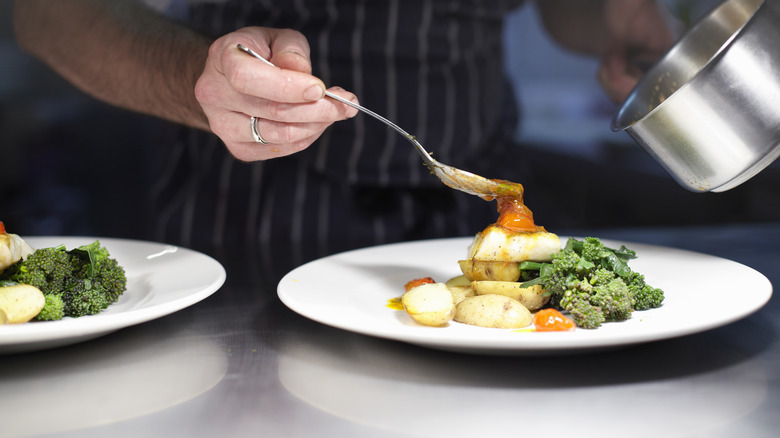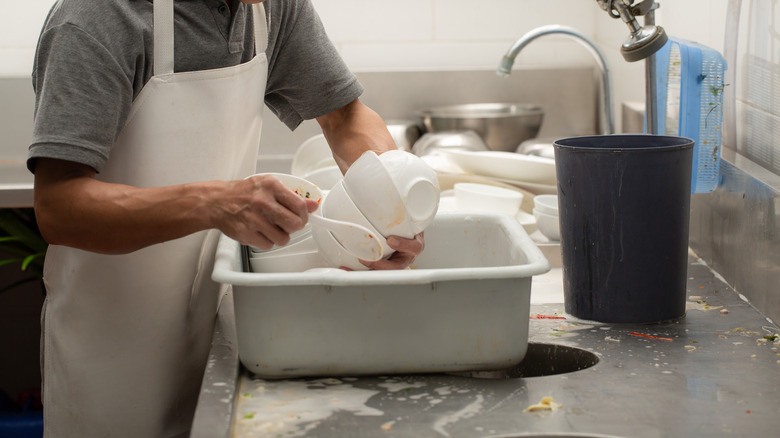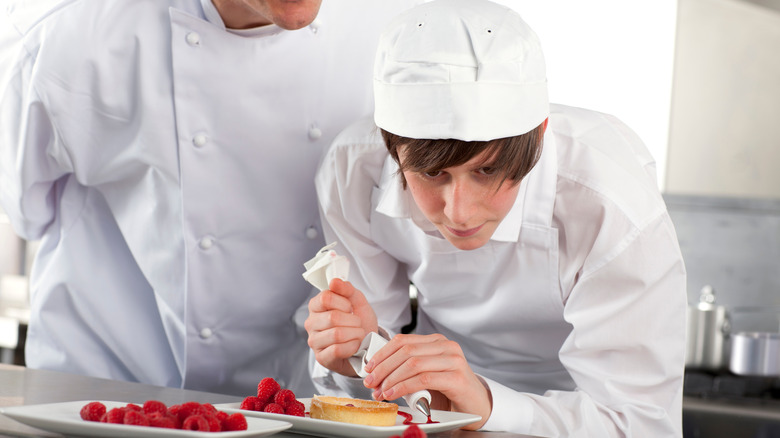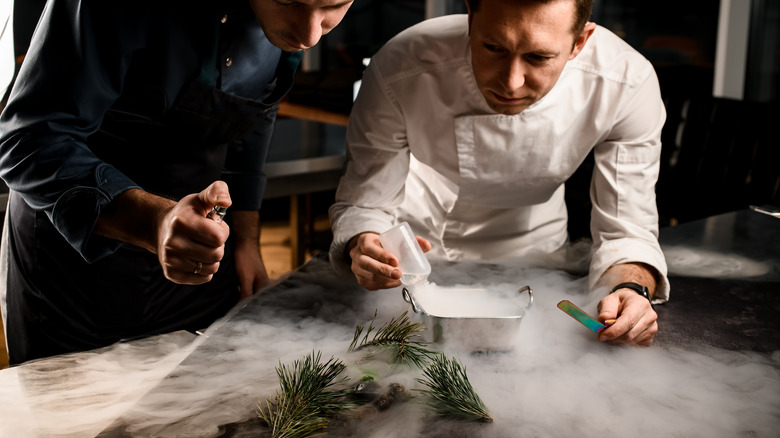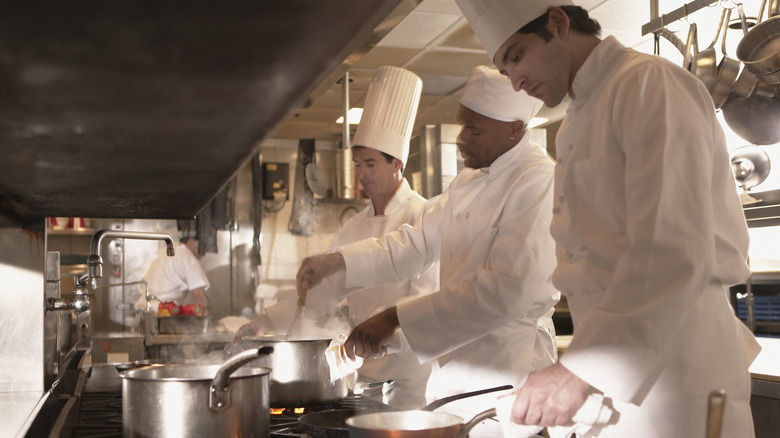Everything You Need To Know About The Kitchen Brigade System
The gleaming stainless steel and fast-paced chaotic energy of the restaurant kitchen fascinates and awes us. It comes as no surprise that open kitchen concepts have boomed in popularity in recent decades, allowing diners a peek into the theater that professional chefs occupy. Tell-all books, movies and TV shows (like FX's "The Bear," which chefs have called almost too real) have proliferated media lately revealing the world of the line cook. Many have wondered exactly how the synchronized performance of the chefs and cooks actually works and how each member knows precisely where to go and what to do.
The foundation of every professional kitchen and the structure of this organization is the brigade system, which was created in France and is used in kitchens around the world. This concept has roots in military organizations and dictates how each person in the kitchen completes their work of creating hot and delicious plates of food. From the executive chef to the dishwasher, every person in the kitchen has a spot in the brigade. But what exactly is it, and how does it work? Read on to discover how the kitchen brigade system plays an important role in the world of the professional chef.
The brigade keeps kitchens organized
Have you ever heard the phrase, "too many cooks in the kitchen?" Most professional kitchens need at least one cook for every 20 diners served in a night (though many Michelin-starred restaurants require many more), so serving hundreds of guests will necessitate a decent-sized team. The only way to efficiently accomplish a dinner service with so many cooks in the cramped quarters of a professional kitchen is to assign everyone a specific task or role.
With the brigade system, however, each cook is assigned a station and rarely has a reason to step more than a few feet in either direction. This saves the cook energy and time and ensures that every person in the kitchen knows their role and what to do. Otherwise, cooks would be running all around the kitchen, bumping into each other, and constantly needing to use the same tools and stations at the same time.
It was created by Escoffier
One of the most famous French chefs of all time, Auguste Escoffier changed the way professional chefs cook. Known as "The King of Chefs and the Chef of Kings," Escoffier helped bring French cuisine from the era of royalty to the modern age. He is credited with inventing everything from the concept of a-la-carte ordering (as opposed to prix fixe) to the mother sauces, as well as many classic French recipes. Also among hiscontributions to the culinary world is the kitchen brigade system.
Thought to have been derived from his time serving in the French army, the kitchen brigade informs the hierarchy of the kitchen and was absolutely essential to Escoffier during his time as chef of some of the best hotels in Europe, such as the Savoy in London and the Ritz in Paris. The kind of culinary excellence that these hotels came to be known for could only have been possible under Escoffier's brigade system.
It is based on French cuisine and dining
Even though the concept of a restaurant has existed for centuries and many kitchens around the world naturally developed similar types of role organization, the kitchen brigade system was invented in France for cooking French food. In French cuisine, all the elements of a dish must be cooked simultaneously and then served on the same plate. The only way to do this efficiently is to break each element apart and assign a specialist to cook each, with one cook or chef to plate it and send it out. The brigade system would look different if it had been based on a different cuisine.
Traditional French dining usually begins with a cold appetizer, which would come from the garde manger station. Main courses are almost always centered around some kind of meat or fish, which is why the brigade system calls for each to have its own dedicated cook. Vegetables often get the star treatment, which calls for a dedicated entremetier.
Every aspect of a dish has a designated cook
Most dishes involve elements made using a variety of cooking styles. A given plate of food might have a piece of grilled meat, sauteed vegetables, a puree and a sauce, plus garnishes. It wouldn't make sense for one cook to run from the grill to the saute station and back again trying to assemble all the components of one plate. To create food most efficiently, each element of a dish is assigned to a certain cook under the brigade system. The grill cook, or rotisseur, would handle the grilled meat, the saucier would prepare all the sauces and purees, and the entremetier would cook the vegetables. Each cook passes the pot or pan of food to the pass where the sous chef assembles the final dish.
This idea isn't restricted to just French and continental cuisine, and many cultures around the world employ the same practice. Take Mexican cuisine, for example. One cook will man the comal making tortillas, while another stands over the grill, fanning the flames. Elements of a dish come from both stations to create the final plate.
The chef executif leads the team
Every team needs a leader, and in a professional kitchen the chef executif, or executive chef, is the CEO. This is the head of kitchen hierarchy and is responsible for every dish the kitchen sends out, though most executive chefs spend very little time cooking. This role involves a lot of managerial work, including accounting, inventory, and other paperwork.
In larger kitchens, the role directly below the executive chef is the chef de cuisine, who is responsible for the chef's duties on the day-to-day when they aren't around and may head the pass, calling out orders during service. Beneath the executive chef and the chef de cuisine are the sous chefs, which act as assistant chefs and perform any and all tasks required of them, including occasionally filling in for line cooks and chefs de partie. Many executive chefs leave a lot of the creative work to the chef de cuisine or sous chefs, though they reserve the final call on any dish.
Specialization leads to perfection
As the great Jacques Pepin once said about cooks, "You have to learn the process. You learn it through endless repetition until it belongs to you." The secret to a cook's ability to achieve perfection dish after dish, night after night, is perfection through repetition. The kitchen brigade system lends itself to specialization, so that one cook creates the same component many, many times, nailing the process a little more each time.
In a world without the brigade, cooks would move about the kitchen, working on something new every day. This calls to mind the famous phrase, "jack of all trades, master of none." True mastery can be achieved in a kitchen by focusing on one station or position until each element is fully understood. In this way, once a cook reaches the level of executive chef, they will have mastered each station in the kitchen and could jump on to any of them at a moment's notice, if need be.
It creates speed and efficiency
In home kitchens, the concept of a "cook's triangle" is used to design the space with maximum efficiency. In theory, a cook should only be a single step away from the stove, the sink, and the refrigerator. In professional kitchens, a similar model is employed, and each cook should only need to take a maximum of two steps around their station for ease of access.
Without the brigade, precious time and energy would be lost as cooks spent time traveling around to various areas of the kitchen. With the brigade, however, each cook's role comes together to create a complicated and delicious dish in a matter of minutes, while it would take a single cook hours to replicate the same dish single-handedly. The synchronization of cooking is what allows the concept of the modern restaurant as we know it today to exist at all.
You must master each level before moving up
The kitchen brigade is based on a hierarchy, much like a branch of the military. A cook cannot move up the ranks before mastering the position they are in. In general, entry level cooks start as stagiaires or commis before moving up to chefs de partie. Most executive chefs want to ensure that a cook is completely in control of their station before moving them up to more complex roles. A cook would not do well on a hot food station, for example, if they cannot handle the pressures of a cold food station.
Depending on the restaurant, some stations may be considered higher than another, equal spot in a different restaurant. For example, the poissonier, or fish cook, at a busy seafood restaurant would likely be considered "above" the rotisseur, or meat cook, based on the typical volume of dishes that come off that station.
Even dishwashers have a role
Even though the lowly dishwasher may seem like an afterthought to most diners, if they are thought of at all, they are an essential part of the kitchen and have a special spot on Escoffier's brigade. Known in French as the plongeur or escuelerie, the dishwasher is responsible for washing all the dishes as well as the cookware, like sauté pans and sheet trays.
In truly well-run restaurants, the dishwasher is one of the chef's most important employees. They can inform the chef if a dish is routinely brought back half-eaten, or save the chef thousands of dollars by properly caring for high-quality cookware. A great dishwasher will also make sure the line cooks are constantly stocked with a supply of clean pots and pans, while a bad one will have the cooks wasting precious time running to the dishpit to grab tools.
Stagiares start on the bottom
Most cooks start their culinary career as apprentices, or stagiares. Often, stagiares are culinary school students on an internship or recent graduates. These cooks have no specific station but instead rotate around the kitchen doing specific and often time-consuming (but simple) tasks. Stagiares are typically asked to do things like peel vegetables, shuck peas, strain stocks, or pick herbs. Mastery of these tasks will lead to promotions to higher stations, with time. From there, the classical brigade system has stagiares move to commis, which is an apprentice of a chef de partie.
Most of the top restaurants around the world rely heavily on the work of stagiares, who commonly work for free or rock-bottom pay in exchange for experience. While this unpaid labor has allowed restaurants to achieve new levels of success and innovation, the world as increasingly turned its attention to these unfair labor practices and some restaurants have even closed because of it.
Sous chefs man the pass
The pass is the term used to describe the counter where finished plates of food cross from the kitchen to the dining room. In some restaurants, the chef or sous chefs stand at the counter and call out orders to the cooks and chefs de partie, waiting for finished plates to come to them to have the edges wiped clean and given a final inspection. It is here that the chef communicates with the dining room and liaises with the expediter, if there is one.
In the traditional brigade, each chef de partie is responsible for a different component of the dish and at the moment of plating, all the pots and pans containing sauce or sauteed vegetables are sent to the pass to be plated by the sous chef. Only a chef with such a senior role could be able to perform such a complex and important task. If the executive chef needed to walk away from calling out orders, the sous chef would move into that role, and another chef in the kitchen would pick up the plating.
The system can be customized to suit the restaurant
Not all restaurants are alike, but the brigade system can be customized to suit the restaurant's needs. Many modern-day restaurants in America have done so, and instead of poissonniers and rotisseurs, it is more common to see stations labelled as sauté or grill, based on the type of cooking that occurs there instead of the type of ingredient.
The customization extends even further than that. For example, in 2015, Lucky Peach reported that famed New York city seafood restaurant Le Bernardin has four stations just for cooking fish. There is a station each for poaching, roasting, sauteing, and sauce. Frasca Food and Wine, in Boulder, Colorado, has a dedicated station for pasta, as well as stations for hot appetizers, cold appetizers, vegetables, and meats. Even a vegetarian restaurant would have each station broken down, and might have a position just for salads, or just soups, for example.
The pastry team has their own roles
The pastry team has their own separate branch of the brigade, just as the main part of the restaurant does. Even though some people might think of the dessert course as an afterthought compared to the main dishes, any quality restaurant puts just as much attention and care into the final bites as it does to any other part of the meal.
Some restaurants only have the space for a single pastry chef, with an apprentice chef de partie underneath them. In extremely small kitchens, the plating of dessert dishes is done by the garde manger cook and the creation and prep for these dishes is done by the chef or a sous chef. Larger kitchens like Eleven Madison Park, in New York City, have dedicated chefs de partie for bread, chocolate, ice cream, and more, all underneath the head pastry chef, who reports to the executive chef.
